Steeped in history and mystery, Tonopah Cemetery is a testament to the trials and tales of Nevada’s silver rush era. Here lie miners, pioneers, and tragic figures, each with a story etched against the backdrop of the rugged desert landscape. As we unravel the enigmatic allure of this resting place, expect to encounter history, heroism, and hauntings that resonate with the spirit of the Old West.
Key Takeaways
- The Old Tonopah Cemetery, established in 1901 and housing approximately 300 graves, tells the rich history of Tonopah’s pioneers, reflecting an era of mining prosperity and the challenges of the Tonopah Plague and the Belmont Mine fire.
- Notable events like the discovery of silver in 1900, which led to Tonopah’s rapid growth and mining success, and tragedies such as the Belmont Mine Fire in 1911 are deeply interwoven with the cemetery’s existence and its poignant memorials to the fallen.
- The Old Tonopah Cemetery no longer accepts new burials due to its closure in 1911, prompted not by overcrowding but by mine tailings damaging the site; a new nearby cemetery now serves the community, while the old site stands as a testament to the town’s dramatic history.
Unveiling the Old Tonopah Cemetery
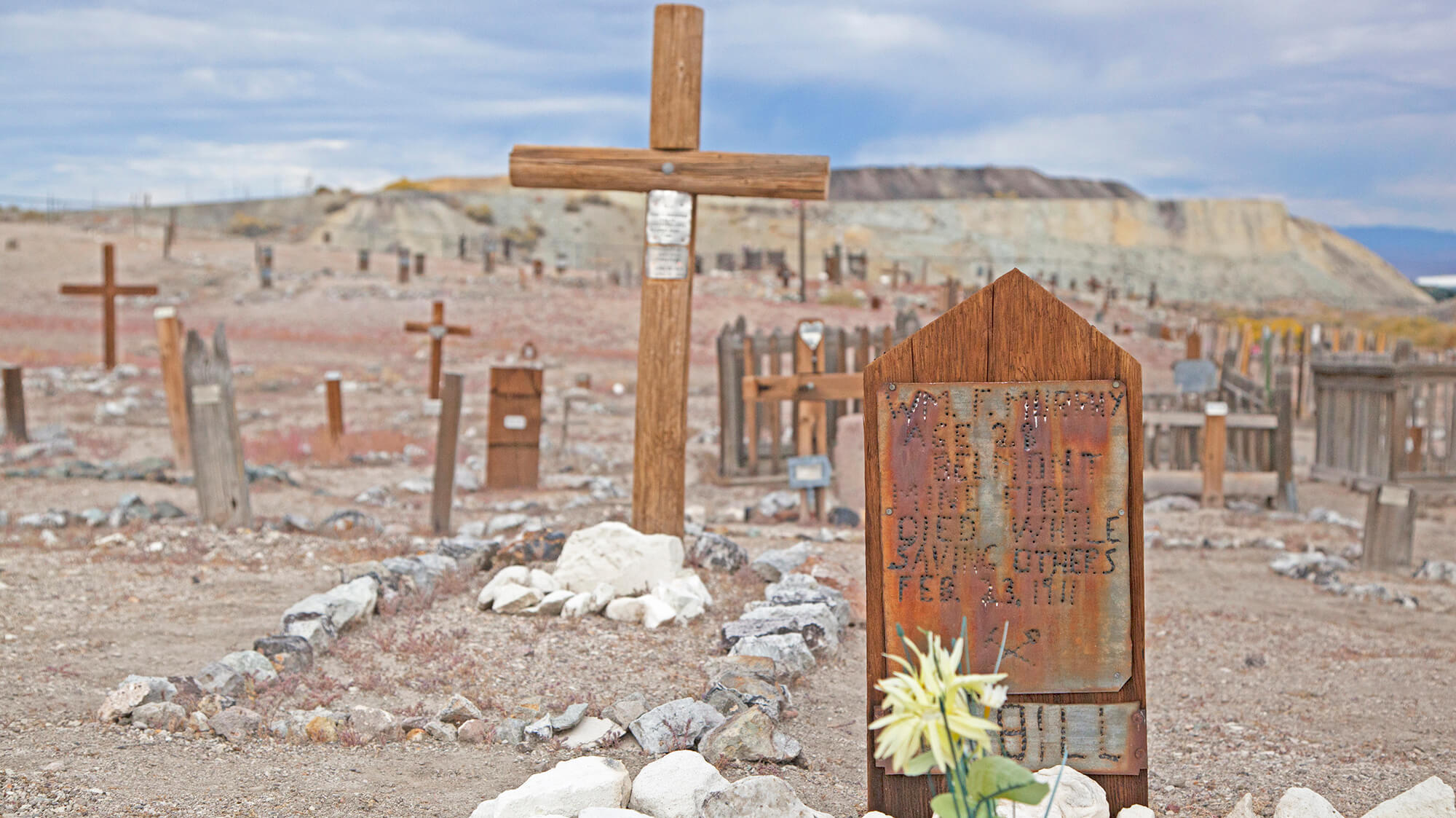
Entering the Old Tonopah Cemetery, established in 1901, feels akin to opening a book to a bygone era. This cemetery, final resting place for Tonopah’s pioneer residents, has silently observed the town’s dynamic history. From an acute pneumonia outbreak known as the ‘Tonopah Plague,’ that claimed over 30 lives under mysterious conditions, to the tragic victims of the Tonopah Belmont Mine fire, each of the 300 graves tells a story of hardship, bravery, and resilience.
Situated in Nye County, the cemetery was a significant part of Tonopah’s formative decade, housing the final resting places for key figures of the town’s history. Notable among them was Nye County Sheriff Thomas Logan, who served with integrity until his untimely death.
The Birth of a Mining Hub
May 1900 marked a turning point for the desert town when prospector Jim Butler discovered a rich silver seam. This discovery led to the creation of the Tonopah Mining Company and marked the birth of Tonopah as a promising mining hub. Within a year, the small town of Butler, later renamed Tonopah, saw a population boom, growing from a modest 14 men to a bustling community of 650.
Tonopah’s mines proved to be a goldmine, literally, churning out nearly $750,000 worth of gold and silver in 1901 alone. This wealth marked the beginning of over 40 years of consistent production and set the stage for the town’s prosperity. Like most mining towns, Tonopah’s fortunes were tied to the Belmont Mine, the source of its wealth and, unfortunately, its tragedies. The success of the Belmont Mine is what Tonopah owes its prosperity to.
Resting Grounds Amidst Booms and Busts

The Old Tonopah Cemetery is a silent witness to Tonopah’s typical cycles of prosperity and decline. Contrary to popular belief, the cemetery’s closure was not due to overcrowding but rather the disruptive tailings from the Tonopah Extension Mine, which damaged graves and headstones. This encroachment of mining activities necessitated the relocation to a new cemetery site, marking the end of an era for the old burial grounds.
The cemetery silently observed the notorious ‘Tonopah plague’ of 1905, a pneumonia outbreak linked to unsanitary conditions around local slaughterhouses. As the town grew in prominence and population, so did the need for a larger cemetery, signaling the end of the Old Tonopah Cemetery’s service to the community as it dead outgrew its capacity.
A Final Farewell to Notable Figures
Many of Tonopah’s notable figures found their final resting place in the Old Tonopah Cemetery. The grave of John Randel Weeks, the pioneer whose burial marked the cemetery’s beginning, is a poignant reminder of the town’s humble beginnings. The grave of County Sheriff Thomas Logan, who was known for his integrity and tragically lost his life outside a local brothel, is another historic landmark in the cemetery.
Some graves of significance in Tonopah include:
- The Merten Brothers, a close-knit trio who passed away within two years of each other, were supported by Tonopah’s strong community, which cared for the surviving family members.
- Bina Verrault
- George ‘Devil’ Davis
- The Marojevich Brothers
- Big Bill Murphy
Each of these individuals has their own story and impact on Tonopah. These stories, etched in stone, form the rich tapestry of Tonopah’s past.
Echoes of Tragedy: The Belmont Mine Fire
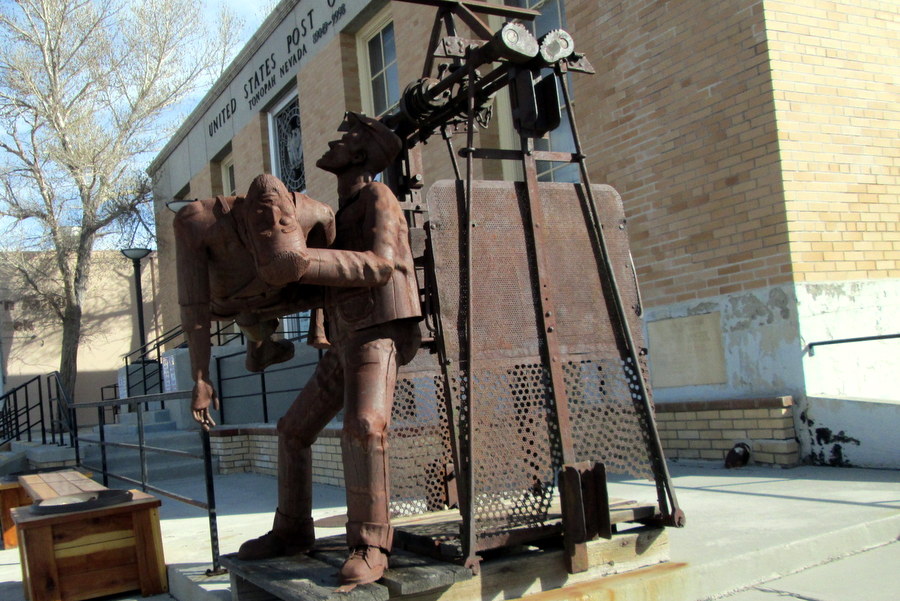
The Belmont Mine Fire of 1911, a tragic mine accident, is a somber chapter in Tonopah’s history, forever memorialized within the cemetery. The fire claimed numerous lives, many of whom were laid to rest in the Old Tonopah Cemetery, marking some of the final burials at this historic site. This tragic event not only marked the end of an era for the original cemetery but also signaled the need for a new burial site.
As the town evolved, the transition to the new Tonopah Cemetery ensured the continuity of honoring the Belmont Mine Fire victims, making sure their place in the town’s memorial narrative was not forgotten.
A Fateful Day in Tonopah History

February 23, 1911, dawned like any other day in Tonopah, but it quickly turned into a nightmare. Smoke was detected from the Belmont Mine early in the morning, but locating the source of the fire proved challenging due to the miners’ unfamiliarity with firefighting and the complex air currents within the mine, causing a dangerous shoot out of smoke. Efforts to control the fire included constructing a barrier and attempting to seal the area of the blaze, but the spreading smoke and poor communication led to miners being trapped and, in some instances, falling while being hoisted to safety.
The blaze was finally extinguished by a committed team on the night of the fire. The following morning, the solemn task of retrieving the bodies began. Fourteen individuals fell victim to the Belmont Mine fire, and the Old Tonopah Cemetery became their final resting place, marking some of the last burials at this historic site.
Honoring the Heroes: Big Bill Murphy and Others
Amid the tragedy of the Belmont Mine Fire, heroes emerged, their bravery forever etched in Tonopah’s history. One such hero was William A. ‘Big Bill’ Murphy. Arriving for his shift, he found the Belmont Mine ablaze with his colleagues trapped inside. Demonstrating exceptional courage, Murphy descended into the Belmont Mine three times, rescuing many of his co-workers.
But heroism often comes at a price. Murphy, after saving numerous lives on his first two descents, succumbed to the fumes and lost his life during his third and final rescue effort. His final resting place is in the Old Tonopah Cemetery, where his epitaph ‘Died While Saving Others’ forever honors his valiant sacrifice.
Spirits of the Clown Motel
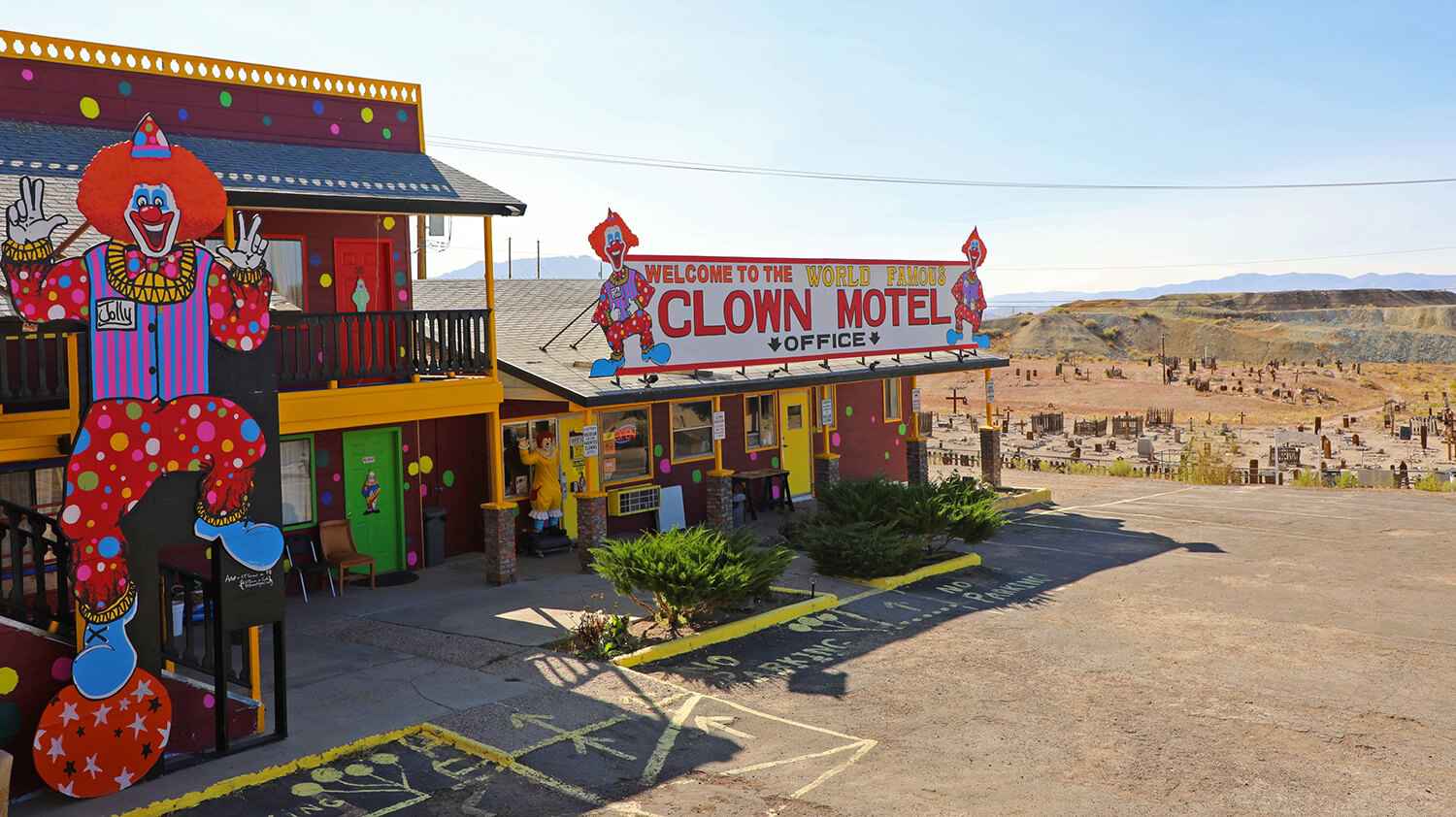
Adding another layer of intrigue to the Tonopah story is the Clown Motel, an establishment intimately linked with the Old Tonopah Cemetery. Known for its paranormal activity, the Clown Motel shares a reputation for being haunted, with claims that the clowns serve as vessels for spirits. Guests at the motel have reported a range of paranormal experiences, such as seeing apparitions, hearing disembodied voices, and encountering a large clown figure, thereby reinforcing the motel’s eerie reputation.
Located in the ghost town of Tonopah, Nevada, the Clown Motel’s proximity to the cemetery significantly contributes to its haunted allure. Paranormal investigators have recorded shadow figures and numerous unexplained phenomena at the motel, further adding to its mystique. The most infamously haunted room at the Clown Motel, room number 108, nicknamed ‘The Trickster’, is a particular focal point for guests seeking the supernatural.
Checking In with the Clowns
Entering the Clown Motel gives you a sense of stepping into an alternate universe. Under new ownership since April 2019, the motel has been transformed to provide guests with a memorable stay, featuring a revamped circus-themed exterior design with polka dots and vibrant clown colors. Greeting guests are two 19-foot tall Jolly Clown cutouts, adding an imposing and thrilling touch to the building’s unique appearance.
Guests have the choice of staying in themed rooms like:
- Exorcist
- IT
- Halloween
- Friday the 13th
Each room is designed to amplify the motel’s eerie ambiance. The Clown Museum on-site has grown its display from around 800 to over 5000 clown figures, turning the space into an extensive attraction. Legends and guest reports suggest that the Clown Motel is haunted, with clown statues acting as vessels for spirits, and there is particularly high paranormal activity reported in Room 108, also known as ‘The Trickster’.
Ghostly Encounters by Night
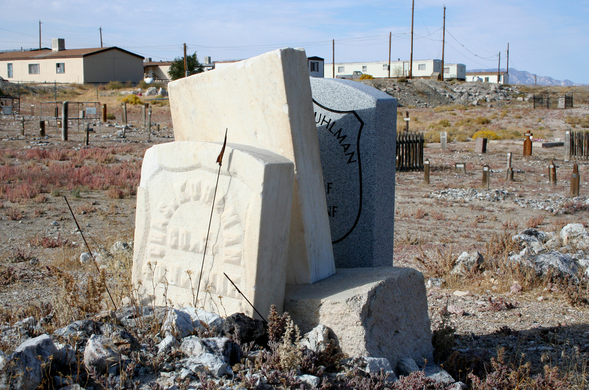
Its proximity to the historic and reportedly haunted Old Tonopah Cemetery makes the Clown Motel a popular spot for ghost hunters and paranormal investigators. Paranormal investigation teams frequently visit the motel and the cemetery, searching for evidence of supernatural activity and encounters with shadowy figures.
Visitors have reported:
- seeing apparitions moving from the cemetery to the motel, including one resembling Clarence David, just a mile west of the location
- hearing mysterious voices uttering phrases like ‘we mined’ and ‘we died that day,’ hinting at the tragic past of the miners
- waking to see a nearly 7-foot-tall clown figure at the foot of their bed
- being too frightened to retrieve their belongings after a night’s stay, contributing to a mass exodus of guests from the motel
These ghostly experiences enrich the narrative of Tonopah Cemetery’s history and contribute to the lasting appeal and mystique of the Clown Motel as a hub for paranormal enthusiasts and tourists alike.
Expansion Beyond the Tiny Plot
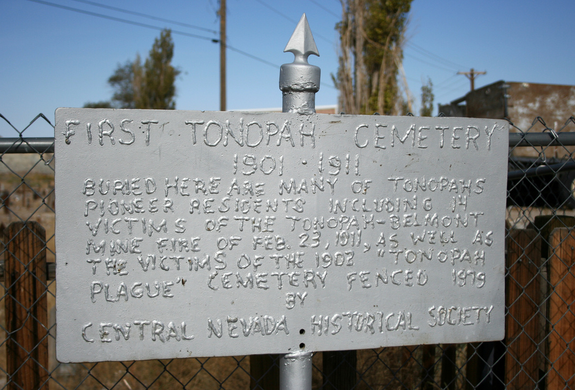
As Tonopah expanded, the need for a more extensive burial ground also increased. The Old Tonopah Cemetery, operational from 1901 to 1911, reached its capacity with around 300 burials, signifying the growth of the town. The cemetery’s closure was not due to overcrowding but rather due to the tailings from the nearby Tonopah Extension Mine, which were causing disruption to the graves and headstones.
To address the need for expansion, the Tonopah Extension Mine donated property for the establishment of a new cemetery, which remains in use today. This transition marked an important evolutionary step for Tonopah, providing a sustainable solution to meet the burial needs of its expanding population.
The Need for More Space
By 1911, the count of deceased individuals in Tonopah had surpassed the capacity of the original cemetery, necessitating a more expansive burial ground. The cemetery was compromised due to tailings from the nearby Tonopah Extension Mine washing over graves and damaging headstones, necessitating the move to a new location.
The establishment of a new cemetery marked an important milestone for the town of Tonopah. It symbolized an evolution in the town’s ability to accommodate its growing population and meet the needs of its residents.
Transition to the New Burial Grounds
The new cemetery was established on land donated by the Tonopah Extension Mine, a testament to the mine’s commitment to the town’s welfare. This donation was aimed at containing the cemetery’s footprint amid their expansion of operations.
The new cemetery served as a testament to Tonopah’s capacity to adapt and grow, accommodating the town’s rapidly growing population. While the Old Tonopah Cemetery closed its doors to new burials, it remained a significant part of the town’s history, its silent tombstones standing as a poignant reminder of the town’s vibrant past and its brave pioneers. The cemetery served Tonopah in different ways, with the old and new cemeteries representing distinct chapters in the town’s story.
Photographic Journey Through Time
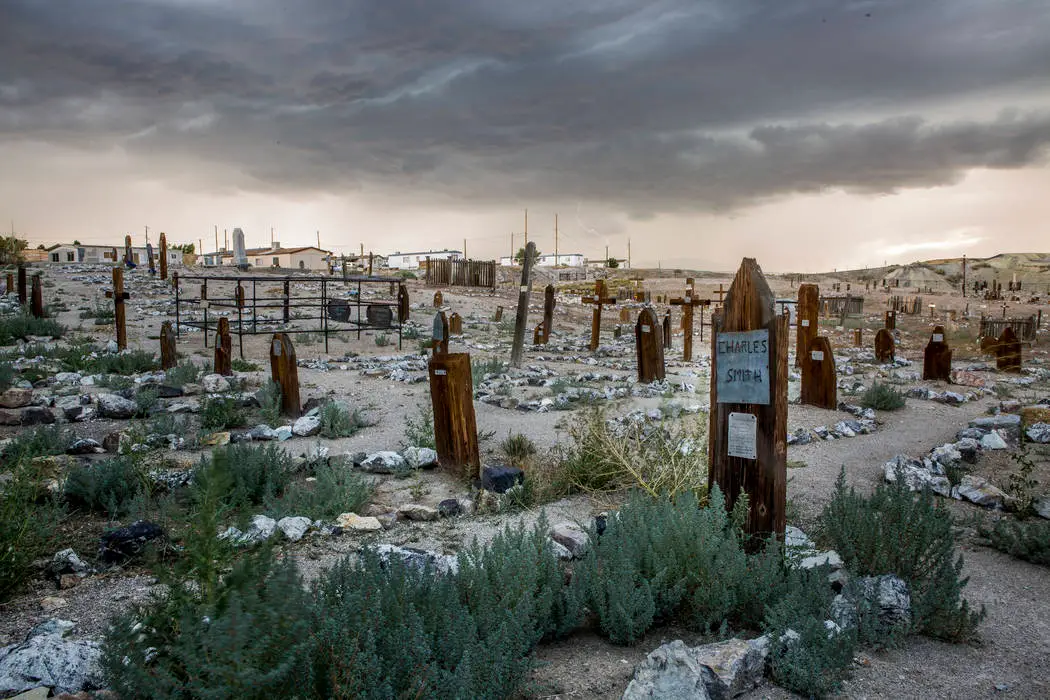
A stroll through the Old Tonopah Cemetery is akin to a journey through time, made richer by a historic map that aids visitors in navigating the site. Through photography, visitors can capture the past, preserving the memories of those buried in the cemetery and providing visual documentation that aids historic research.
Photographs of cemeteries serve as enduring memoirs, documenting the timeless beauty and history reflected in tombstones and memorials. The stories behind the headstones can be further explored through online newspaper archives or the Central Nevada Museum’s research library, offering a deeper understanding of Tonopah’s history.
Capturing the Past
Cemetery photography, an art in itself, encapsulates the narratives and emotions tied to historical sites, transforming ordinary monuments into compelling visual narratives. It involves not just technical skill but also an understanding and appreciation of the cemetery’s sacredness and historical importance.
Only about 30% of the headstones in the Old Tonopah Cemetery are original; many were rebuilt in recent decades with old material to maintain an authentic appearance. These photographs serve as a crucial tool in:
- capturing the historical essence of the cemetery
- preserving the memories of those buried there
- providing visual documentation that aids historic research.
Faces of the Unknown
Gravestone inscriptions, including dates and symbols, offer insights into the lives of those buried in the cemetery that would otherwise remain obscure. Photography serves as a powerful tool in unveiling these unknown faces of Tonopah’s past.
The walking tour of the cemetery gives equal importance to the unknown figures alongside notable individuals, bridging the gap between the recognized and the lesser-known. These forgotten faces of Tonopah, once unearthed and documented, contribute to the rich tapestry of the town’s storied mining past.
Summary
From its birth as a mining hub to its growth and the need for a larger cemetery, Tonopah’s history is intricately intertwined with the Old Tonopah Cemetery. The haunting charm of this heritage site lies in the stories of the people who rest there – the miners, the victims of the Tonopah Plague, the heroes of the Belmont Mine Fire, and the unknown faces that form the rich tapestry of the town’s past. As we journey back in time, we are reminded that these silent tombstones are not just markers of death but symbols of life, courage, and resilience.
If you’re looking for an RV park to stay in Tonopah, look no further than Tonopah RV. Explore the rich history of this town and experience its haunting charm at the Old Tonopah Cemetery.
Frequently Asked Questions
Who is buried in Tonopah Cemetery?
Two of the most famous graves in Tonopah Cemetery are “Big Bill Murphy” and Nye County Sheriff Thomas Logan.
Why is Tonopah famous?
Tonopah is famous for being home to the creepiest hotel in America, the Mizpah Hotel, which is said to be haunted by the “Lady in Red,” a working girl who was allegedly murdered by her jealous ex-lover.
What caused the Tonopah plague?
The Tonopah plague was caused by pneumonia, which was attributed to poor sanitation.
What does the name Tonopah mean?
The name Tonopah is most likely derived from the Shoshone or Northern Paiute languages, meaning “greasewood water.” This reflects the importance of water sources in the area occupied by these Native American tribes.
Best RV park in Tonopah?
The premier RV park in Tonopah undoubtedly is Tonopah RV. With its convenient location, top-notch facilities, and professional service, Tonopah RV guarantees a comfortable and enjoyable stay.
Is there a cemetery next to the Clown Motel?
Yes, there is a cemetery located next to the Clown Motel in Tonopah, Nevada. It adds to the allure and, for some, its creepiness.
